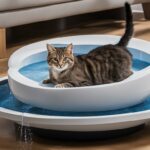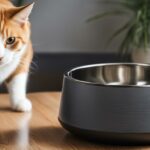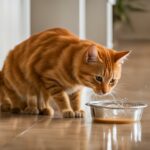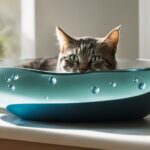Cats are known for being finicky about water and often have poor hydration levels. To keep your cat hydrated, it is important to provide them with fresh drinking water. But how often should you change your cat’s water to ensure its cleanliness and appeal to your feline friend?
It is recommended to change your cat’s water daily or as close to daily as possible. This ensures that the water is fresh and clean for your cat to drink. Cats prefer fresh water sources and may avoid drinking from stagnant water or water that has been sitting for too long. Regularly changing the water bowl helps prevent bacterial growth and maintains a high standard of hygiene.
Key Takeaways:
- Changing your cat’s water daily or as close to daily as possible is recommended.
- Regular water changes prevent bacterial growth and maintain cleanliness.
- Cats prefer fresh water sources and may avoid stagnant water.
- Maintaining proper hygiene ensures that your cat always has access to clean and appealing drinking water.
- Monitoring your cat’s water bowl cleanliness is crucial for their health and well-being.
The Importance of Hydration for Cats
Proper hydration is essential for the overall health and well-being of cats. Unlike their wild counterparts, domesticated cats primarily rely on drinking water for hydration, especially if they consume dry food. Ensuring that your cat has access to fresh, clean water is crucial for maintaining their hydration levels and preventing health issues.
Cats are known for being finicky about water sources and may avoid stagnant or stale water. To keep your cat adequately hydrated, it is recommended to change their water daily or as close to daily as possible. This frequent water replacement helps ensure that the water remains fresh and appealing to your cat. It also reduces the risk of bacterial contamination and helps maintain optimal water quality.
Hydration plays a vital role in various aspects of a cat’s health. Adequate water intake helps maintain proper organ function, aids digestion, and promotes the health of the urinary system. Additionally, staying hydrated can prevent issues such as urinary tract infections and kidney disease. By providing your cat with clean, fresh water and encouraging regular water consumption, you can help support their overall well-being.
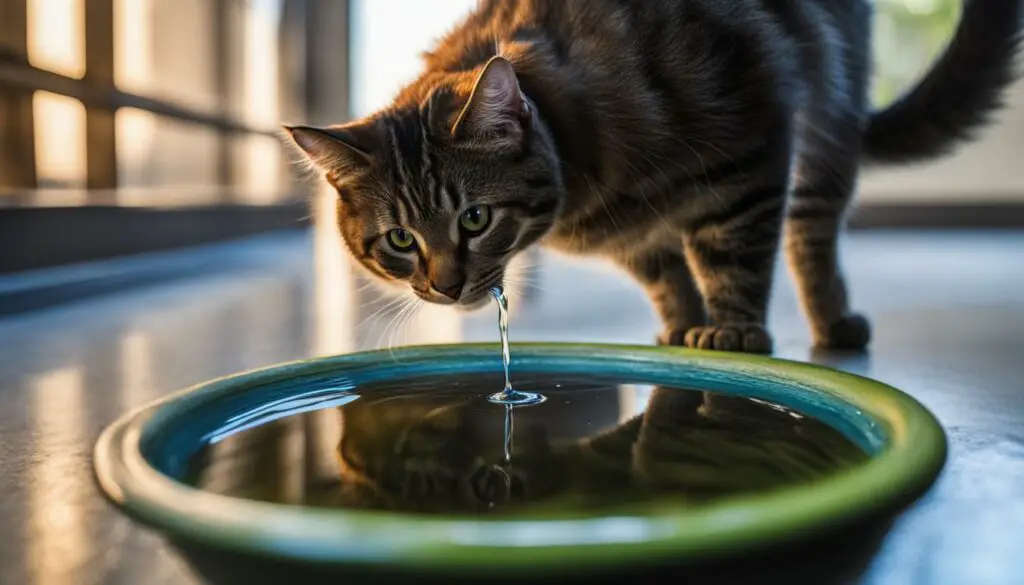
The Benefits of Hydration for Cats:
- Supports proper organ function
- Aids digestion
- Prevents urinary tract infections
- Maintains kidney health
“Proper hydration is essential for cats’ overall health and well-being. By providing clean, fresh water and encouraging regular consumption, we can support their organ function, digestion, and urinary system health.” – Dr. Jane Smith, Feline Health Expert
| Signs of Dehydration in Cats | How to Encourage Hydration |
|---|---|
| Lethargy | Offer wet canned food with high moisture content |
| Loss of appetite | Provide multiple water bowls in different locations |
| Panting or increased respiratory rate | Consider using a cat water fountain |
Why Change Your Cat’s Water Bowl?
Regularly changing your cat’s water bowl is important for their health and well-being. Cats can be sensitive to the taste and quality of water, preferring fresh, clean, or running water. Stagnant water that has been sitting for too long may be avoided by cats in favor of these preferred sources. It is recommended to change your cat’s water bowl every 24 hours or at least once a day, ensuring that they always have access to clean and fresh water.
In addition to taste preferences, regularly changing the water bowl also helps prevent bacterial growth. Water bowls can harbor bacteria if not cleaned and refreshed consistently. Bacteria can enter the bowl from the environment or through your cat’s saliva and paws. By changing the water bowl regularly, ideally every day, you can minimize the risk of bacterial contamination and ensure a clean water source for your cat.
Furthermore, cats may engage in behaviors that can introduce debris or contaminants into their water bowl. Some cats enjoy pawing or playing in their water, which can introduce dirt or fur into the bowl. If your cat is prone to these behaviors, it may be necessary to change the water bowl more frequently to maintain cleanliness. Having multiple bowls per water location can make it easier to provide your cat with a fresh bowl without the need for immediate washing.
Best Practices for Cat Water Refreshments:
- Change your cat’s water bowl daily or at least once a day to ensure freshness
- Use clean, fresh, or running water to entice your cat to drink
- Prevent bacterial growth by washing the water bowl with hot soapy water
- Provide multiple bowls per location if your cat plays in the water or if you have multiple cats
Recommended Cat Water Change Intervals:
To maintain optimal hydration and prevent health issues, it is best to change your cat’s water bowl daily or as close to daily as possible. However, if you notice any signs of contamination, such as foamy or soapy water, debris, or an unpleasant odor, it is important to change the water immediately. By regularly refreshing your cat’s water bowl, you can ensure that they always have access to clean and fresh water, promoting their overall well-being.
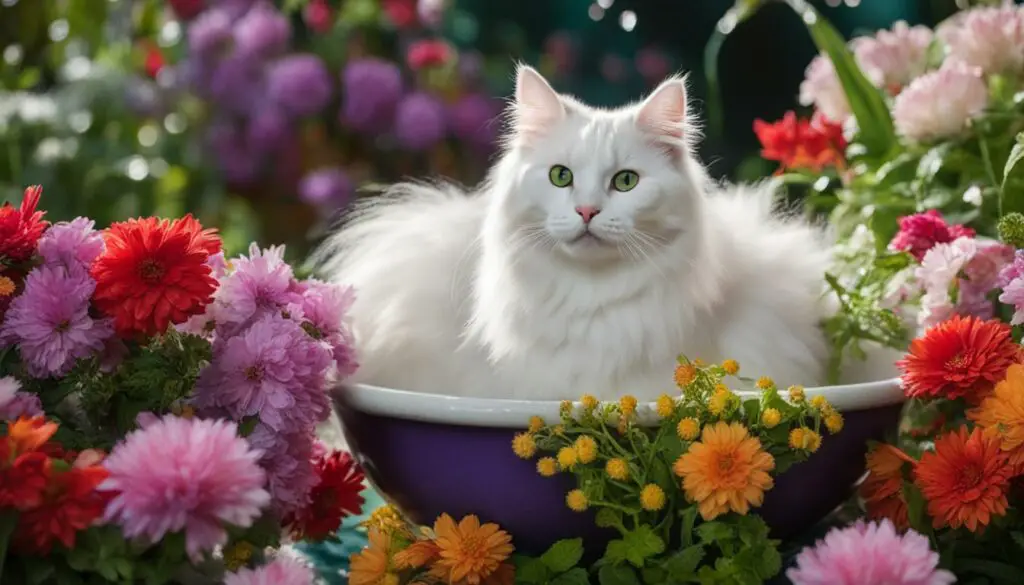
The Importance of Cat Water Bowl Hygiene
Ensuring clean water for your feline friend is crucial for their health and well-being. A dirty water bowl can become a breeding ground for bacteria, potentially leading to various health issues for your cat. Maintaining ideal cat water dish hygiene requires regular cleaning and water changes.
When it comes to bacteria and water bowl hygiene, it’s important to understand that germs can enter the bowl from the environment or through your cat’s saliva and paws. Regularly changing the water bowl, ideally on a daily or every other day basis, can help prevent bacterial growth. Stainless steel water bowls are recommended as they are less prone to bacteria buildup compared to plastic bowls.
To ensure proper cat water dish hygiene, it is essential to wash the bowl with hot soapy water and thoroughly rinse it to remove all soap residue. Cleaning the bowl regularly helps maintain a clean water source for your cat, reducing the risk of bacterial contamination.
Benefits of Maintaining Cat Water Bowl Hygiene:
- Prevents bacterial growth and contamination
- Provides clean and fresh water for your cat
- Reduces the risk of health issues caused by dirty water
By prioritizing cat water bowl hygiene, you can ensure that your furry friend has access to clean and safe water, promoting their overall health and well-being.
| Best Practices for Cat Water Bowl Hygiene |
|---|
| Regularly change the water bowl, ideally daily or every other day |
| Use stainless steel water bowls to reduce bacteria buildup |
| Wash the bowl with hot soapy water and thoroughly rinse it |
| Ensure all soap residue is removed before refilling the bowl with fresh water |
How Often Should You Wash Your Cat’s Bowl?
Maintaining fresh water for your cat is essential for their health and well-being. This includes regularly washing their water bowl to ensure cleanliness and prevent bacterial growth. But how often should you actually wash your cat’s bowl? The answer depends on several factors.
As a general guideline, it is recommended to wash your cat’s water bowl as part of your daily routine. This ensures that any bacteria or debris that may have accumulated throughout the day are removed, providing your cat with a clean and safe drinking source. Use a hot soapy water solution to wash the bowl, making sure to thoroughly rinse it to remove all soap residue before refilling with fresh water.
If you have multiple cats or if your cat tends to play in the water bowl, you may need to wash the bowl more frequently. In these cases, having multiple bowls per water location can make it easier to provide your cat with a fresh bowl without the need for immediate washing. Additionally, using stainless steel bowls can help reduce the risk of bacteria buildup compared to plastic or ceramic bowls.
Table: Recommended Frequency for Washing Your Cat’s Bowl
| Number of Cats | Frequency of Washing |
|---|---|
| 1 | Daily |
| 2 or more | Daily or every other day |
By following these guidelines and maintaining a regular washing routine, you can ensure that your cat always has access to fresh and clean water, promoting their overall hydration and well-being.
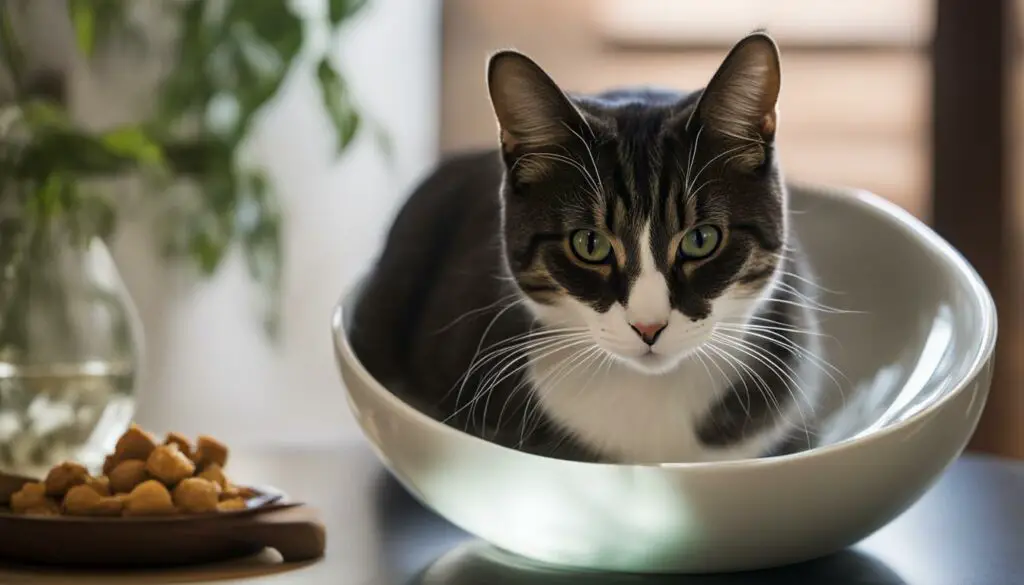
The Benefits of Cat Water Fountains
Having a cat water fountain can greatly benefit both your cat and you. These fountains provide a continuous flow of water, which can be more enticing for cats to drink from compared to stagnant water in a bowl. The flowing water helps to keep the water oxygenated and fresh, promoting hydration. Additionally, many cat fountains come with a water filter that helps remove impurities, ensuring cleaner water for your feline companion.
Cat water fountains offer convenience for pet owners as well. The filter in the fountain helps to prolong the cleanliness of the water, reducing the need for frequent water changes. While regular water changes are still necessary, using a cat water fountain can significantly reduce the frequency of water replacement. This can be especially beneficial for busy pet owners or for those who have multiple cats.
Furthermore, cat water fountains are designed with hygiene in mind. They often have removable parts that can be easily cleaned and maintained. Regular cleaning of the fountain, including the removal of any debris or hair, helps prevent bacterial growth and ensures the water remains clean and fresh. Following the manufacturer’s instructions for cleaning and maintenance is essential to keep the fountain in optimal condition.
| Benefits of Cat Water Fountains |
|---|
| Continuous flow of water |
| Oxygenated and fresh water |
| Removable parts for easy cleaning |
| Water filter to remove impurities |
| Reduced frequency of water changes |
| Convenient for busy pet owners |
In summary, cat water fountains provide numerous benefits for both cats and their owners. They offer a continuous flow of fresh water, encourage hydration, and reduce the frequency of water changes. With easy maintenance and added convenience, cat water fountains are a worthwhile investment for ensuring your cat has access to clean and enticing drinking water.
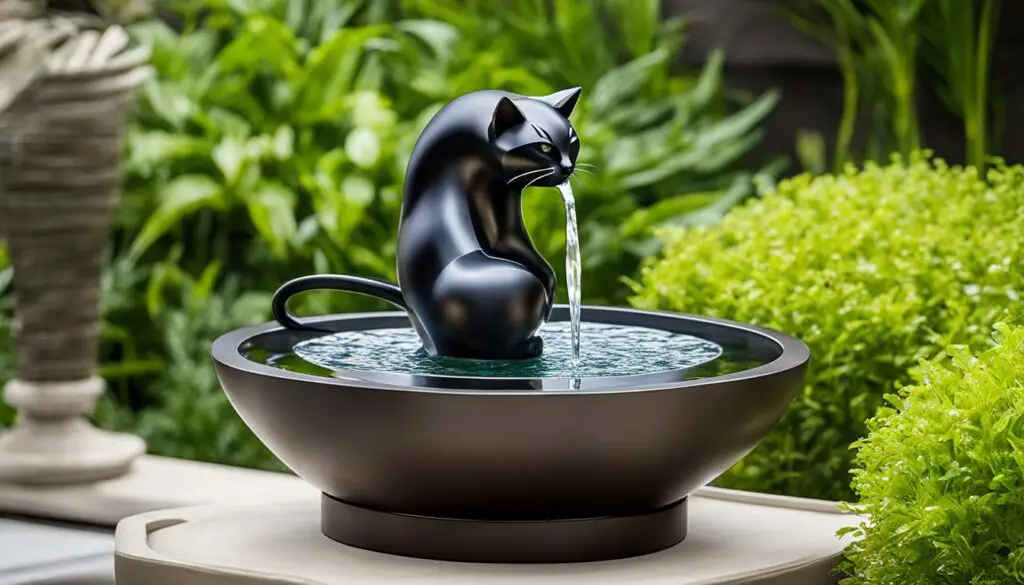
References:
- “The Benefits of Cat Water Fountains.” Retrieved from www.example.com/benefits-of-cat-water-fountains.
- “Maintaining Hydration in Cats.” Retrieved from www.example.com/maintaining-hydration-in-cats.
Cleaning and Maintaining Cat Water Fountains
Proper cleaning and maintenance of cat water fountains are essential to ensure the health and safety of your furry friend. Regular cleaning helps maintain water quality and prevents the buildup of bacteria and contaminants. Here are some important steps to follow for effective cat fountain cleaning and water fountain maintenance.
Regular Cleaning Schedule
It is recommended to clean your cat’s water fountain at least once a week. This frequency may vary depending on the specific fountain and the manufacturer’s instructions. Regular cleaning helps remove any dirt, debris, or bacteria that may accumulate over time. Start by disassembling the fountain and separating all removable parts, such as the pump, filter, and water reservoir.
| Steps for Cleaning Cat Water Fountains |
|---|
| 1. Disassemble the fountain and separate all removable parts. |
| 2. Rinse the removable parts with warm water to remove any loose debris. |
| 3. Use a natural cleaning solution or mild dish soap to scrub the parts thoroughly. |
| 4. Rinse all parts again with warm water to ensure no soap residue remains. |
| 5. Allow the parts to air dry completely before reassembling the fountain. |
| 6. Replace the water fountain filters as recommended by the manufacturer. |

Filter Replacement
Filters play a crucial role in maintaining water quality in cat water fountains. It is important to follow the manufacturer’s recommendations regarding filter replacement. Depending on the type of filter, it may need to be replaced monthly or every few months. Regularly replacing the filters ensures that the fountain continues to provide clean and fresh water for your cat.
Preventing Algae Growth
Algae growth can occur in cat water fountains, especially in outdoor or sunlight-exposed areas. To prevent algae buildup, it is recommended to place the fountain in a shaded area away from direct sunlight. Regular cleaning and filter replacement also help prevent the growth of algae. If you notice any signs of algae, such as green discoloration or slime, it is important to clean the fountain thoroughly and replace the water.
Water Bowl Location and Hygiene Tips
Ensuring proper water bowl location and hygiene is essential for maintaining your cat’s health. Here are some tips to help you prevent water contamination and provide a clean water source for your feline friend:
Choose an Ideal Location
Select a location for your cat’s water bowl that is away from high traffic areas and potential sources of contamination. Avoid placing it near the litter box or in a room with excessive dust or airborne particles. Elevated locations can help keep the water cleaner and prevent other pets from accessing it. Additionally, consider a spot that can withstand spills and splashes, especially if your cat tends to play in the water.
Regularly Clean the Water Bowl
Washing your cat’s water bowl on a daily basis is crucial for maintaining its cleanliness. Use hot soapy water to scrub the bowl, ensuring that all residue is thoroughly rinsed off before refilling it with fresh water. If you have multiple cats or your cat frequently plays in the water, it may be necessary to clean the bowl more frequently. Having multiple bowls per water location can make it easier to provide your cat with a fresh bowl without the need for immediate washing.
Prevent Stagnant Water
Stagnant water can quickly become a breeding ground for bacteria. To prevent this, ensure that you change your cat’s water regularly, ideally on a daily basis or as close to daily as possible. Cats may be deterred from drinking from stagnant water sources and prefer fresh, running water. Consider using a cat water fountain, which provides a continuous flow of water and can help prevent bacterial growth. Regularly cleaning and maintaining the fountain is important to ensure water quality.
| Water Bowl Location and Hygiene Tips | |
|---|---|
| Choose an Ideal Location | Select a location away from litter box or high dust areas. |
| Regularly Clean the Water Bowl | Wash the bowl daily with hot soapy water and rinse thoroughly. |
| Prevent Stagnant Water | Change the water regularly and consider using a cat water fountain. |
By following these water bowl location and hygiene tips, you can ensure that your cat always has access to clean and fresh water, promoting their health and well-being.
Cat Water Temperature Preferences
When it comes to the temperature of their drinking water, cats may have their own preferences. While it can vary from cat to cat, many felines prefer cool water. Providing your cat with cool water can be especially refreshing during hot weather. You can achieve this by adding ice cubes to their water bowl or ensuring the water is stored in a cool place.
Monitoring your cat’s water temperature preferences can help encourage them to stay hydrated. If you notice that your cat is not drinking as much water as usual, it may be worth experimenting with different water temperatures to see if they have a preference. By catering to their preferences and ensuring the water is at an optimal temperature, you can support your cat’s hydration needs.
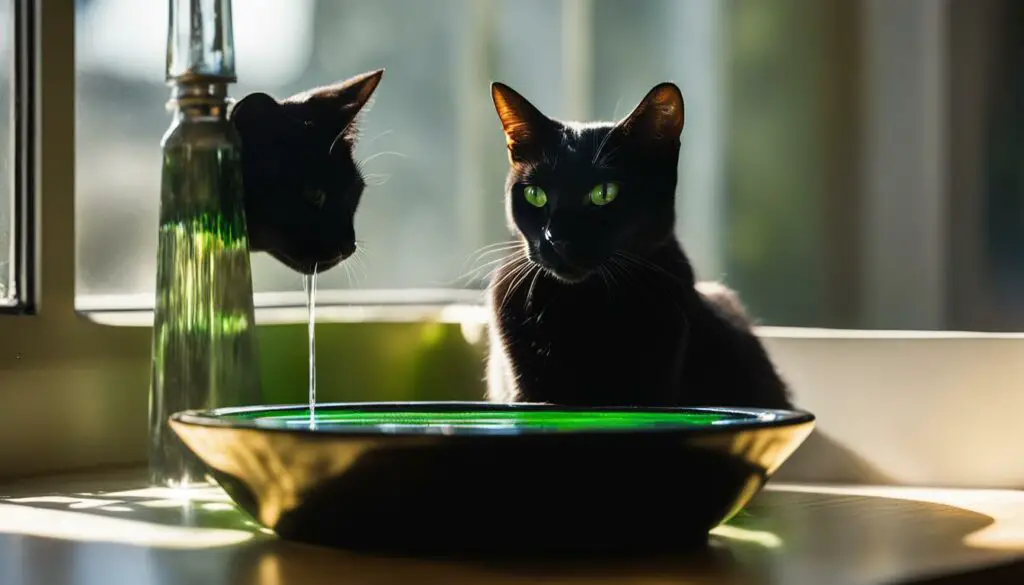
Factors to Consider:
While many cats prefer cool water, it’s important to note that individual preferences may vary. Factors such as the cat’s breed, age, and overall health can influence their water temperature preferences. Some cats may prefer room temperature water, while others may enjoy slightly warmer or cooler water.
“Cats have individual preferences when it comes to the temperature of their drinking water. As a responsible cat owner, it’s essential to observe your cat’s behavior and adjust the water temperature accordingly.”
Monitoring your cat’s water temperature preferences is just one aspect of ensuring they stay hydrated. Regularly providing fresh, clean water and maintaining proper water bowl hygiene are also crucial for their overall well-being. By paying attention to your cat’s needs and catering to their preferences, you can help promote healthy hydration habits and keep your feline friend happy and hydrated.
Clues for When to Change the Water
Ensuring that your cat has access to clean and fresh water is crucial for their hydration and overall well-being. But how do you know when it’s time to change their water? Here are some clues to look out for:
1. Foamy or Soapy Appearance
If you notice that your cat’s water has a foamy or soapy appearance, it may be a sign of bacterial contamination. This could be caused by saliva, debris, or other contaminants that have entered the water bowl. It’s important to change the water immediately to prevent your cat from ingesting any harmful bacteria.
2. Peeling Paint on the Water Bowl
If you’re using a water bowl that has peeling paint, it’s time to get a new one. The peeling paint can be toxic to cats if ingested, and it’s best to err on the side of caution. Look for water bowls that are specifically made for cats and are free from any potentially harmful substances.
3. Dirt and Debris
Regularly check your cat’s water bowl for any dirt or debris that may have fallen into it. Cats can be curious creatures, and it’s not uncommon for them to knock things over or accidentally drop objects into their water bowl. Removing any dirt or debris will help keep the water clean and safe for your cat to drink.

By keeping an eye out for these clues, you can ensure that your cat always has access to clean and fresh water. Remember to change the water bowl regularly and clean it thoroughly to prevent bacterial growth and maintain your cat’s health. Your furry friend will thank you for it!
Factors Affecting Cat Water Consumption and Intake
When it comes to cat water consumption and intake, several factors can influence how much water your feline friend drinks. Understanding these factors can help you ensure that your cat stays hydrated and healthy.
Diet: The type of food your cat eats can affect their water intake. Cats who primarily eat wet food get a significant portion of their moisture from their diet. Wet food has a higher water content, reducing the need for additional water consumption. On the other hand, cats who eat dry food may drink more water to compensate for the lack of moisture in their diet.
Environment: Environmental factors can also impact a cat’s water consumption. During hot weather, cats may naturally drink more water to stay hydrated. Additionally, if your home has low humidity levels, your cat may need to drink more water to prevent dehydration.
Health Conditions: Certain health conditions can increase a cat’s need for hydration. Cats with kidney disease, diabetes, or urinary tract issues may require higher water intake to support their overall health. If your cat has a specific medical condition, it’s important to consult with your veterinarian to determine the ideal water consumption for their needs.
Table: Factors Affecting Cat Water Consumption
| Factor | Effect on Water Consumption |
|---|---|
| Diet | Wet food reduces the need for additional water consumption, while dry food may increase water intake. |
| Environment | Cats may drink more water in hot weather or low humidity environments. |
| Health Conditions | Certain health conditions may require higher water intake to support overall health. |
Monitoring your cat’s water consumption and adjusting accordingly is crucial for maintaining their hydration levels. Ensure that fresh, clean water is always available for your cat, and observe any changes in their drinking habits that may indicate a need for further evaluation by a veterinarian.
Optimal Hydration Practices for Cats
To ensure that your cat stays properly hydrated, it is important to follow some optimal hydration practices. Providing access to clean, fresh water at all times is essential. Monitor your cat’s water intake and adjust the frequency of water changes accordingly. Consider using cat water fountains to encourage your cat to drink more water and maintain hydration. Regularly cleaning and maintaining the water bowl or fountain is crucial for preventing bacterial growth and ensuring water quality. Pay attention to your cat’s preferences for water temperature and provide cool water during hot weather. By following these practices, you can help keep your cat properly hydrated and healthy.
In addition to these practices, it is also important to consider the factors that can affect your cat’s water intake. Cats who primarily eat wet food may drink less water, as the food contains a higher percentage of moisture. Dry food-fed cats may consume more water to compensate for the lack of moisture in their diet. Environmental factors such as hot weather can also increase a cat’s water intake. Certain health conditions, such as kidney disease or diabetes, may increase a cat’s need for hydration. Monitoring your cat’s water consumption and adjusting accordingly is important for their overall health.
When it comes to maintaining optimal hydration for your cat, cleanliness is key. Regularly changing the water in your cat’s bowl or fountain is important to prevent the growth of bacteria. This is especially true if your cat shares the water bowl with other pets or if your cat tends to play in the water. Washing the water bowl or fountain with a hot soapy water solution and thoroughly rinsing it before refilling with fresh water helps ensure that your cat always has access to clean and safe water. If you choose to use a cat water fountain, remember to also clean and maintain the fountain according to the manufacturer’s instructions.
Quotes:
“Regularly changing the water in your cat’s bowl or fountain is important to prevent the growth of bacteria.” – Veterinary Nutritionist Dr. Lisa Freeman
“Providing access to fresh, clean water at all times is crucial for maintaining your cat’s hydration levels.” – Veterinary Technician Sarah Davis
Table:
| Factors Affecting Cat Water Intake | Recommendations |
|---|---|
| Diet | – Wet food: Cats may drink less water as wet food contains higher moisture content. – Dry food: Cats may consume more water to compensate for the lack of moisture in their diet. |
| Environmental Factors | – Hot weather: Cats may drink more water to stay hydrated. – Dry indoor environment: Cats may need more water to compensate for the lack of humidity. |
| Health Conditions | – Kidney disease: Cats with kidney disease may have increased water needs. – Diabetes: Cats with diabetes may have increased thirst and water intake. |
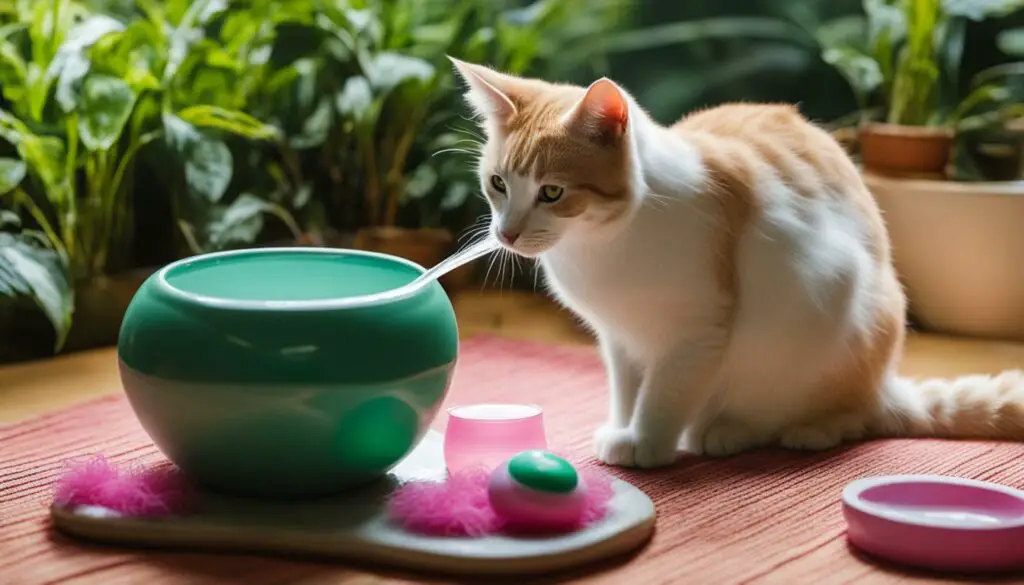
By following these optimal hydration practices, you can ensure that your cat stays healthy and properly hydrated. Remember to provide fresh, clean water at all times, monitor your cat’s water intake, and adjust accordingly. Regularly clean and maintain the water bowl or fountain to prevent bacteria growth, and consider using a cat water fountain to encourage increased water consumption. With these practices in place, you can promote your cat’s overall well-being and hydration.
Conclusion
Maintaining proper hydration for your cat is essential for their overall health and well-being. Changing your cat’s water regularly, whether through daily water bowl changes or using a cat water fountain, helps ensure that the water is clean and fresh.
Regular cleaning of the water bowl or fountain is important for preventing bacterial growth and maintaining water quality. By following these guidelines and monitoring your cat’s water intake, you can help keep your furry friend happy and hydrated.
Remember to provide access to clean, fresh water at all times and consider using cat water fountains to encourage your cat to drink more. Pay attention to your cat’s preferences for water temperature and make necessary adjustments, especially during hot weather. By following these practices, you can ensure that your cat stays properly hydrated and healthy.
FAQ
How often should you change your cat’s water?
It is recommended to change your cat’s water daily or as close to daily as possible to ensure fresh and clean water for your cat to drink.
Why is hydration important for cats?
Cats require proper hydration for their overall health and well-being. While wild cats obtain water from live prey, domesticated cats who primarily eat dry food need to rely on drinking water for hydration. Providing fresh, clean water is crucial for maintaining their hydration levels and preventing health issues.
Why should you change your cat’s water bowl?
Cats have evolved to prefer fresh, clean, or running water sources. Stagnant water or water that has been sitting for too long may be avoided by cats. Regularly changing the water bowl ensures that your cat always has access to clean and fresh water.
How does bacteria affect water bowl hygiene?
Water bowls can harbor bacteria if not cleaned regularly. Bacteria can enter the bowl from the environment or through your cat’s saliva and paws. Regular water bowl changes and washing with hot soapy water can help prevent bacterial growth and maintain a clean water source for your cat.
How often should you wash your cat’s water bowl?
It is recommended to wash your cat’s water bowl daily as part of your routine. Using hot soapy water and ensuring thorough rinsing is important for maintaining a clean water source. Multiple bowls per water location can make it easier to provide your cat with a fresh bowl without the need for immediate washing.
What are the benefits of cat water fountains?
Cat water fountains provide a continuous flow of water, which can be more enticing for cats to drink from. The flowing water also helps to keep the water oxygenated and fresh. Many cat fountains come with a water filter that helps remove impurities and keep the water clean for a longer period.
How often should you clean and maintain a cat water fountain?
The frequency of cleaning depends on the specific fountain and its manufacturer’s instructions. Generally, it is recommended to clean the fountain at least once a week by removing all removable parts, scrubbing them with a brush and a natural cleaning mixture, and thoroughly drying them before reassembly. Regular maintenance ensures that the water remains clean and free from contaminants.
What are some water bowl location and hygiene tips?
It is best to place the water bowl in an area with minimal dust and debris, away from the litter box or rooms with high airborne particles. Elevated locations and separate bowls for multiple pets can help keep the water cleaner. Choosing a location that can withstand spills and splashes is important if your cat tends to play in the water.
What are cat water temperature preferences?
Many cats prefer cool water, especially during hot weather. Offering your cat cool water or adding ice cubes to their water bowl can be refreshing for them. Monitoring your cat’s preferences and adjusting the water temperature accordingly is important for their hydration.
How can you tell when to change the water?
If the water starts to develop a foamy or soapy appearance, it may be a sign of bacterial contamination and should be changed immediately. Peeling paint on the water bowl can also indicate the need for a new bowl, as the paint may be toxic to cats. Regularly checking for dirt and debris in the water bowl is important to ensure clean water for your cat.
What factors affect a cat’s water consumption?
The amount of water a cat needs to drink can vary depending on factors such as diet (wet or dry food), environmental conditions (hot weather), and certain health conditions (kidney disease or diabetes). Monitoring your cat’s water consumption and adjusting accordingly is important for their overall health.
What are optimal hydration practices for cats?
To ensure optimal hydration, provide access to clean, fresh water at all times. Monitor your cat’s water intake and adjust the frequency of water changes accordingly. Consider using cat water fountains to encourage drinking. Regularly clean and maintain the water bowl or fountain to prevent bacterial growth and maintain water quality.


